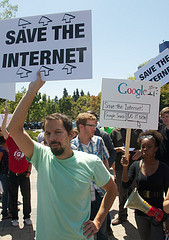Why net-neutrality might not be realistic!
 Quick and dirty attempt to lay down my current thoughts about the whole net neutrality issue.
Quick and dirty attempt to lay down my current thoughts about the whole net neutrality issue.
What ?
Net neutrality is about providing to users the same quality of service (ie. mainly the bandwidth capacity you paid for) to access all services on the internet. In other words, an internet service provider (ISP) should not discriminate one traffic over another. Since it does concern the last mile infrastructure it depends on the local regulations which means obviously that it might be different from one country to the other.
Problem ?
To keep growing and monetize their infrastructure ISP needs to find new revenue flow and one outcome could be to head towads tiered-internet. ISP might be tempted to make pay selected services for a better quality of service (ie. insure bandwidth) on their network, hence granting for the end user the best possible experience for this service. While getting the best service possible without spending a penny sounds good for the end users (ie. us), it has a drawback: it gives priority on the network to the companies that have the most money, and since start-ups are not part of those it would basically kill innovation.
Four reasons why net neutrality is not realistic…
1 – Over the last decades all our content has transformed into bytes. Music, Radio, Books, Television, Voice are all content being digitalized and their relative markets are being disrupted by Internet. More content moved on the network means more traffic to handle for the service provider. The most popular Over-the-top service in US – Netflix – represents more than 20% of downstream Internet traffic during peak time. Real-time entertainment traffic, that includes video streaming, is growing at a pace that emperils the pipe of the service provider.
2 – More and more devices are net-enabled To consume digitalized content. In-Stat reports that by 2014, average US Consumer households will own between 5 and 10 web-enabled devices. I am not sure what they define as a web-enabled device – probably something that includes a display ? – but I am already over the 10 connected devices, granted I am not an “average houselhold” when it comes to electronic device :-)
3 – ISP have tried multiple times to leverage their network to build services on top but they mainly failed. Think about the number of services you are using that comes from one of your ISP ? If you are like me probably close to none. I use my internet service provider (net2000) for what it is… a network infrastructure provider, and not an email or storage provider. Same is valid with my mobile service provider, I am using (for now) Swisscom for voice and data (ie. internet connectivity). I am definitively not using their email service and even less their freaking useless mobile portal for which they try to make me pay every single bit of information they have on it. No basically they failed to find alternatives sources of revenue.
4 – Multiple System Operator (MSO) have also become ISP. Big content network became by way of acquisitions or investments also Internet Service Provider. Those have a lot of content that they will want to prioritize when they will be lacking some bandwidth.
Conclusion
More traffic, more bandwidth needed and no additional revenue to help them grow will leave the ISP with only one choice to monetize their infrastructure: leveraging their network by prioritizing the traffic and you can achieve that from the two ends of the value chain: charge the end user for the traffic or prioritize the traffic for the services that pays the most.
Push-back
“There is no network problem that can be solve by prioritization that can not be solved by increasing the bandwidth”
I heard that one and I would have to double check if it is true. Probably more true for wired than wireless but in any case increasing the bandwidth has a cost! Who is going to pay for it ?
Also read:
Network neutrality on Wikipedia
Network neutrality in the United States on Wikipedia
Image under CC Steve Rhodes
